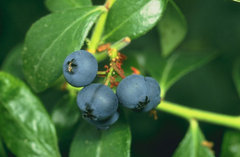| Blueberry | ||||||||||||
|---|---|---|---|---|---|---|---|---|---|---|---|---|
| Scientific classification | ||||||||||||
| ||||||||||||
| Species | ||||||||||||
| Vaccinium angustifolium |
Blueberry refers to some plants of the genus Vaccinium, which also includes cranberries, bilberries (also called blueberry), and many wild shrubs producing edible, round, blue berries (botanically false berries) with flared "crowns" at the end. The fruit are first white, then reddish-purple, and turn blue on ripening; the fruit are also called blueberries, and have a sweet taste. Blueberries are used in jellies, jams, pies, and many other snacks and delicacies.
Blueberries are both cultivated and picked wild. In North America, the most common cultivated species is V. corymbosum, the Northern Highbush Blueberry. Hybrids of this with other Vaccinium species adapted to southern US climates are known collectively as Southern Highbush Blueberries.
Wild blueberries, smaller and much more expensive than cultivated ones, are prized for their intense flavour and colour. The Lowbush Blueberry, V. angustifolium, is found from Newfoundland westward and southward to Michigan and West Virginia. In some areas it produces natural blueberry barrens, where it is practically the only species covering large areas. Several First Nations communities in Ontario are involved in harvesting wild blueberries.
In the US, Maine is the largest producer of Lowbush Blueberries. The Maine crop requires about 50,000 beehives for pollination, with most of the hives being trucked in from other states for that purpose.
Michigan, New York, New Jersey and North Carolina are large producers of Highbush Blueberries.
Rabbiteye, V. ashei, is a southern type of blueberry produced from the Carolinas to the Gulf Coast states.
Other important species in North America include V. pallidum, the Hillside or Dryland Blueberry. It is native to eastern USA, but common in the Appalachians and the Piedmont of the Southeast. Sparkleberry, V. arboreum, is a common wild species on sandy soils in the southeastern US. Its fruit are important to wildlife, and the flowers important to beekeepers.
At the 2004 International Conference on Longevity, a group of researchers released details of a study that suggests certain compounds found in blueberries (and some similar fruits, including cranberries) have a significant impact in reducing the degradation of brain function, as in Alzheimer's Disease and other conditions ([1] (http://www.alzheimers.org/nianews/nianews23.html), [2] (http://www.abc.net.au/rn/talks/natint/stories/s1059896.htm)).
See also
References
- Joseph, J.A., Shukitt-Hale B., Denisova, N.A. Bielinksi D., Martin, A., McEwen, J.J., & Bickford, P.C., 1999. Reversals of age-related declines in neuronal signal transduction, cognitive, and motor behavioral deficits with blueberry, spinach, or strawberry dietary supplementation. Journal of Neuroscience 19 (18): 8114-8121.

